Huygens probe
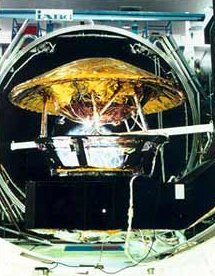
Huygens undergoing testing.
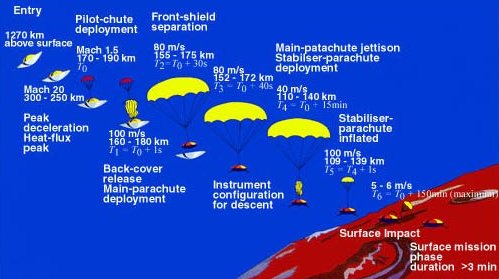
Huygens' descent to Titan.

Artist's conception of Huygens on Titan.
The Huygens probe was the European Space Agency (ESA) component of
the NASA Cassini mission to Saturn and its environs. Huygens, named in honor of the Dutch scientist Christaan Huygens, was an atmospheric probe designed to
make in situ observations of Saturn's largest moon, Titan. It was released
by the Cassini orbiter in November 2004 and entered the atmosphere of Titan three weeks later.
Huygens' objectives were to:
· Determine the physical characteristics (density, pressure, temperature, etc.) of Titan's atmosphere as a function of height
· Measure the abundance of atmospheric constituents
· Investigate the atmosphere's chemistry and photochemistry, especially with regard to organic molecules and the formation and composition of aerosols
· Characterize the meteorology of Titan, particularly with respect to cloud physics, lightning discharges, and general circulation
· Examine the physical state, topography, and composition of the surface
Spacecraft, subsystems, and science experiments
Huygens consisted of two pieces of apparatus: the probe and the probe support equipment (PSE). The probe itself consisted of two elements as well: the aeroshell, which protected the instruments during the high-velocity entry into Titan's atmosphere, and the descent module, which contained the scientific instrumentation. The descent module was enclosed in the aeroshell. They were mechanically attached to each other at three locations.
The aeroshell was comprised of two parts: a front shield and a back cover. The front shield was a 79-kilogram, 2.7-5-meter-diameter, 60-degree half-angle coni-spherical surface. Tiles of "AQ60" ablative material (a felt of phenolic resin reinforced by silica fibers) provided protection against the heat of entry into Titan's atmosphere. The supporting structure was a carbon fiber reinforced plastic honeycomb shell, also designed to protect the descent module from the heat generated during entry. The tiles were attached to the supporting structure by an adhesive. A suspension of hollow silica spheres in a silicon elastomer (Prosial) was sprayed directly on the aluminum structure of the rear surface of the front shield to further insulate the surface. The back cover, which experienced far less heating during atmospheric entry, carried multi-layer insulation to protect the probe during the cruise phase to Saturn and during the coast phase. A hole in the cover allowed for depressurization during launch and allowed for repressurization during entry. It was an 11.4-kilogram stiffened aluminum shell protected by a 5-kilogram coating of Prosial.
The descent module consisted of a forward dome and an after cone which surrounded the experiment platform. A top platform completed the enclosure. The forward dome and the top platform contained a variety of ports to permit experiment sensors access to the atmosphere and to provide a means for deployment of the parachutes.
The PSE, although a part of the Huygens system, remained attached to the Cassini orbiter. Its purpose was to support the probe and provide power to the probe prior to separation and to provide communications between the probe and orbiter both prior to and after separation. It also provided the spin given to the probe during the separation process.
Power for the Huygens probe after separation was provided with five LiSO2 batteries capable of storing 1600 watt-hours of energy and could supply about 250 watts of power for the planned three hours of probe operation. For thermal control, the probe used multiple layers of insulation and about 35 watts of radioisotope heater units. A power conditioning distribution unit (PCDU) handled the distribution and conversion of orbiter energy and probe battery energy to all experiments and sub-systems of the probe. It also provided arming and firing functions of pyro lines. Prior to separation, all power to the probe was provided by the Cassini orbiter.
Probe events were controlled via both software and hard-wired sequences, including a triply-redundant wake-up timer and a g-switch to detect deceleration of the probe by Titan's atmosphere. Redundant radar altimeters measured altitude from 20 km down, each transmitting 60 milliwatts of power at 15.4 or 15.8 gigahertz via a 125 × 162 millimeter planar slot antenna.
Huygens carried a complement of six scientific instruments.
Huygens Atmospheric Structure Instrument (HASI)
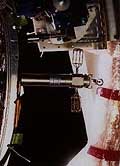 |
This instrument contained a suite of sensors that measured the physical and electrical properties of Titan's atmosphere. Accelerometers measured forces in all three axes as the probe descended through the atmosphere. Since the aerodynamic properties of the probe were already known, it was possible to determine the density of Titan's atmosphere and detect wind gusts. Had the probe landed on a liquid surface, this instrument would have been able to measure the probe motion due to waves. Temperature and pressure sensors also measured the thermal properties of the atmosphere. The Permittivity and Electromagnetic Wave Analyzer component measured the electron and ion (i.e., positively charged particle) conductivities of the atmosphere and searched for electromagnetic wave activity. On the surface of Titan, the conductivity and permittivity (i.e., the ratio of electric flux density produced to the strength of the electric field producing the flux) of the surface material was measured.
Doppler Wind Experiment (DWE)
 |
The intent of this experiment was to measure the wind speed during Huygens' descent through Titan's atmosphere by observing changes in the carrier frequency of the probe due to the Doppler effect. This measurement could not be done from space because of a configuration problem with one of Cassini's receivers. However, scientists were able to measure the speed of these winds using a global network of radio telescopes.
Descent Imager/Spectral Radiometer (DISR)
 |
This instrument made a range of imaging and spectral observations using several sensors and fields of view. By measuring the upward and downward flow of radiation, the radiation balance (or imbalance) of the thick Titan atmosphere was measured. Solar sensors measured the light intensity around the Sun due to scattering by aerosols in the atmosphere. This permitted the calculation of the size and number density of the suspended particles. Two imagers (one visible, one infrared) observed the surface during the latter stages of the descent and, as the probe slowly rotated, built up a mosaic of pictures around the landing site. There was also a side-view visible imager that obtained a horizontal view of the horizon and the underside of the cloud deck. For spectral measurements of the surface, a lamp switched on shortly before landing that augmented the weak sunlight.
Gas Chromatograph Mass Spectrometer (GCMS)
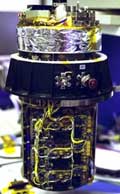 |
This instrument was a versatile gas chemical analyzer that identified and measured chemicals in Titan's atmosphere. It was equipped with samplers that were filled at high altitude for analysis. The mass spectrometer built a model of the molecular masses of each gas, and a more powerful separation of molecular and isotopic species was accomplished by the gas chromatograph. During descent, the GCMS analyzed pyrolysis products (i.e., samples altered by heating) passed to it from the Aerosol Collector Pyrolyser. Finally, the GCMS measured the composition of Titan's surface in the event of a safe landing. This investigation was made possible by heating the GCMS instrument just prior to impact in order to vaporize the surface material upon contact.
Aerosol Collector and Pyrolyser (ACP)
 |
This experiment drew in aerosol particles from the atmosphere through filters, then heated the trapped samples in ovens (the process of pyrolysis) to vaporize volatiles and decompose the complex organic materials. The products were then flushed along a pipe to the GCMS instrument for analysis. Two filters were provided to collect samples at different altitudes.
Surface-Science Package (SSP)
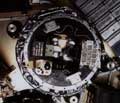 |
The Surface-Science Package contained a number of sensors designed to determine the physical properties of Titan's surface at the point of impact. These sensors also determined whether the surface was solid or liquid. An acoustic sounder, activated during the last 100 meters (328 feet) of the descent, continuously determined the distance to the surface, measuring the rate of descent and the surface roughness (e.g., due to waves). During descent, measurements of the speed of sound provided information on atmospheric composition and temperature, and an accelerometer accurately recorded the deceleration profile at impact, providing information on the hardness and structure of the surface. A tilt sensor measured any pendulum motion during the descent and indicated the probe attitude after landing.
Huygens consisted of two pieces of apparatus: the probe and the probe support
equipment (PSE). The probe itself consisted of two elements as well: the
aeroshell, which protected the instruments during the high-velocity entry
into Titan's atmosphere, and the descent module, which contained the scientific
instrumentation. The descent module was enclosed in the aeroshell. They
were mechanically attached to each other at three locations.
The aeroshell was comprised of two parts: a front shield and a back cover. The front shield was a 79-kilogram, 2.7-5-meter-diameter, 60-degree half-angle coni-spherical surface. Tiles of "AQ60" ablative material (a felt of phenolic resin reinforced by silica fibers) provided protection against the heat of entry into Titan's atmosphere. The supporting structure was a carbon fiber reinforced plastic honeycomb shell, also designed to protect the descent module from the heat generated during entry. The tiles were attached to the supporting structure by an adhesive. A suspension of hollow silica spheres in a silicon elastomer (Prosial) was sprayed directly on the aluminum structure of the rear surface of the front shield to further insulate the surface. The back cover, which experienced far less heating during atmospheric entry, carried multi-layer insulation to protect the probe during the cruise phase to Saturn and during the coast phase. A hole in the cover allowed for depressurization during launch and allowed for repressurization during entry. It was an 11.4-kilogram stiffened aluminum shell protected by a 5-kilogram coating of Prosial.
The descent module consisted of a forward dome and an after cone which surrounded the experiment platform. A top platform completed the enclosure. The forward dome and the top platform contained a variety of ports to permit experiment sensors access to the atmosphere and to provide a means for deployment of the parachutes.
The PSE, although a part of the Huygens system, remained attached to the Cassini orbiter. Its purpose was to support the probe and provide power to the probe prior to separation and to provide communications between the probe and orbiter both prior to and after separation. It also provided the spin given to the probe during the separation process.
Power for the Huygens probe after separation was provided with five LiSO2 batteries capable of storing 1600 watt-hours of energy and could supply about 250 watts of power for the planned three hours of probe operation. For thermal control, the probe used multiple layers of insulation and about 35 watts of radioisotope heater units. A power conditioning distribution unit (PCDU) handled the distribution and conversion of orbiter energy and probe battery energy to all experiments and sub-systems of the probe. It also provided arming and firing functions of pyro lines. Prior to separation, all power to the probe was provided by the Cassini orbiter.
Probe events were controlled via both software and hard-wired sequences, including a triply-redundant wake-up timer and a g-switch to detect deceleration of the probe by Titan's atmosphere. Redundant radar altimeters measured altitude from 20 kilometers down, each transmitting 60 milliwattsW
of power at 15.4 or 15.8 GHz via a 125 × 162 millimeter planar slot antenna.
Mission profile
During the cruise phase to Saturn, Huygens was attached to Cassini and,
in the main, dormant. Periodic checks of its status were carried out and
its health remained solid.
The first two orbits around Saturn were designed to set up the necessary
trajectory for deployment of the Huygens probe on the third orbit. A maneuver
took place in December 2004 that placed the paired spacecraft on an intersect
course with Titan. The probe was released from the orbiter at 02:00 UTC
on 25 December 2004 and was targeted for a 10 degrees South latitude landing
site on the "day" side of Titan. The two spacecraft separated with a relative
velocity of 0.3-0.4 meters per second but remained in the same orbit for about three weeks.
At that time, Cassini executed a deflection maneuver to enable it to fly
by Titan at an altitude of 60,000 kilometers and positioned it to receive transmissions
from Huygens as it entered Titan's atmosphere, some 2.1 hours prior to Cassini's
closest approach. Entry into the atmosphere occurred on 14 January 2005. The
probe entered Titan's atmosphere on 14 January 2005 at a velocity of 6.1 kilometers per secod
(13,725 mph). The entry phase lasted about 3 minutes, during which the aeroshell
surrounding the descent module reduced the probe's velocity to about 400
meters per second (about 895 mph).
Three parachutes were used during the probe's descent. When the onboard
accelerometers detected a speed of Mach 1.5 near the end of the deceleration
phase (altitude about 175 kilometers or 100 miles), the 2-meter (6.6-foot)-diameter
pilot parachute deployed, pulling off the aft cover. This was followed immediately
by deployment of the 8.3-meter (27-foot) main parachute. About 30 seconds after
deployment of the main chute, the probe's velocity dropped from Mach 1.5
to Mach 0.6. The front heat shield was then released, and the probe descended
slowly below the main parachute for about 15 minutes while initial scientific
measurements were made. A swivel on the parachute harness enabled the module
to spin during descent to provide scan for its camera. The main parachute
then separated from the probe, at an altitude of about 40 kiloetersm, and released
a smaller 3-meter (9.8-foot) drogue parachute, which allowed the probe to descend
faster, and ensured it would reach the surface before the batteries expired.
It arrived at the surface in 2.5 hours, with an impact velocity of about
7 meters per second (15 mph).
For the scientific results returned by Huygens, see the article on Titan.


